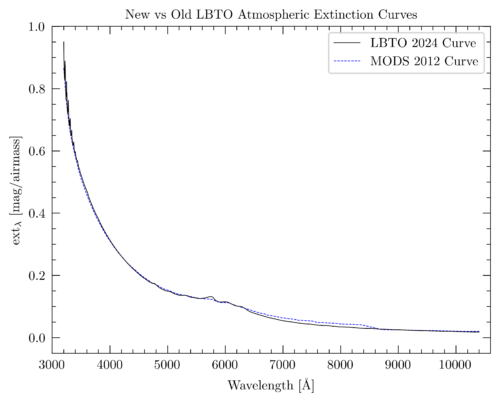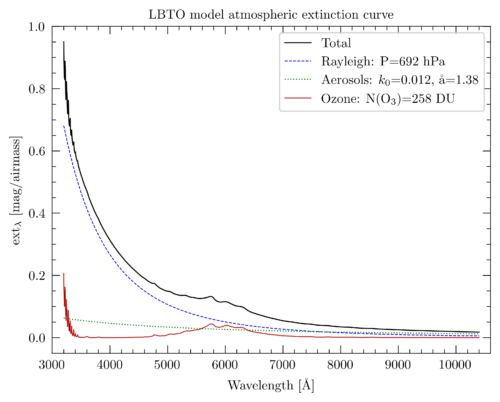Spectrophotometric Standards (updated 2024-11-04)
This page was updated on 2024-11-04. Note that changes were made to the set of MODS Primary Spectrophotometric Standards and that the LBT Model Extinction curve has been revised. The old page is here.
MODS Primary Spectrophotometric Standards
Because MODS works from 3200 to >~10000 Å, spectrophotometric standard stars with good fluxes from the UV to the near-IR are needed to adequately calibrate the data. A set of 5 stars form the preferred set of spectrophotometric standards for MODS (the “MODS primary spectrophotometric standards”): the 3 primary HST calibrators, G191-B2B, GD 71 and GD 153 (Bohlin, Colina and Findlay 1995); along with Feige 34 and Feige 110. Long term MODS users will note that this is a significant reduction from the set of 11 stars that have been put forth as “MODS Primary spectrophotometric standards” since May 2014. Experience has shown that these 5 provide the most stable response curves, and, being hot white dwarfs, do not have a multitude of absorption lines in the blue which can complicate fitting the wiggles from the dichroic transmission for dual grating spectra. Two more stars were retained: Hz 43 and BD +28 4211; as the latter, in particular, fills a gap in the RA coverage, though work is ongoing to add new white dwarfs from the CALSPEC database. The legacy list of 11 stars is available here.
Data on the MODS Primary Spectrophotometric Standards
Data on the MODS primary spectrophotometric standards are provided in Table 1 below. The coordinates, proper motions, spectral type and magnitudes are from Simbad.
Acquisition and observation scripts for these stars may be generated from the MODS OT library and are also available on the mountain (obsN) workstations in /lbt/lbto/mods/modsScripts/modsSpecPhot/.
Table 1: MODS Primary Spectrophotometric Standards
| Star |
RA
(J2000)
|
Dec
(J2000)
|
Sp Type |
m(5556)
(mag)
|
pmRA
(mas/yr)
|
pmDec
(mas/yr)
|
t[Grating]
(sec)
|
t[Prism]
(sec)
|
Downloads |
|---|---|---|---|---|---|---|---|---|---|
| G191-B2B [1] | 05:05:30.613 | +52:49:51.96 | DA.8 | 11.85 | +7.45 | -89.54 | 90 | 10 | Finder Chart 10Å Flux Table 50Å Flux Table |
| GD71 [2] | 05:52:27.614 | +15:53:13.75 | DA1.5 | 13.03 | +85 | -174 | 180 | 30 | Finder Chart 10Å Flux Table 50Å Flux Table |
| Feige 34[3] | 10:39:36.740 | +43:06:09.26 | sdO | 11.25 | +14.09 | -25.01 | 120 | 15 | Finder Chart 10Å Flux Table 50Å Flux Table |
| GD 153 [4] | 12:57:02.337 | +22:01:52:68 | DA1.2 | 13.35 | -46 | -204 | 180 | 30 | Finder Chart 10Å Flux Table |
| Hz 43 [5] | 13:16:21.853 | +29:05:55.38 | DA[1] | 12.91 | -157.96 | -110.23 | 180 | 30 | Finder Chart 10Å Flux Table |
| BD+28 4211 [6] | 21:51:11.021 | +28:51:50.36 | sdOp | 10.56 | -35.55 | -58.74 | 60 | 10 | Finder Chart 10Å Flux Table 50Å Flux Table |
| Feige 110[3] | 23:19:58.398 | -05:09:56.16 | sdO | 11.88 | -10.68 | +0.31 | 90 | 10 | Finder Chart 10Å Flux Table 50Å Flux Table |
[1] – G191-B2B is an HST primary white dwarf standard star. On the finder chart it is the northernmost of the two bright stars in the field.
[2] – GD71 is an HST primary white dwarf standard star. The NIR extension is based on HST model spectrum.
[4] – GD153 is an HST primary white dwarf standard star. The NIR extension is based on the HST fluxes shifted by -0.02mag.
[5] – A faint binary M-dwarf companion, Hz43B (V=14.3), is located 3-arcsec away, so this star is not recommended during poor seeing. Hz 43 used to be among the set of HST primary white dwarf stars, but was removed because the M-dwarf was contaminating the STIS data (Bohlin, Gordon & Tremblay 2014, PASP, 126, 711). In MODS red-channel acquisition images, the M-dwarf outshines the standard star. The M-dwarf also appears brighter at the central wavelength of MODS red-channel spectra, so automatic trace-finding algorithms may mistake it for the standard. Like the HST primary WD stars, HZ43’s NIR extension is based on the HST model spectrum.
Flux Tables
CALSPEC database
All of the MODS primary spectrophotometric standards are in the HST CALSPEC database and have HST STIS & NICMOS data with wavelength sampling from ~2.7Å in the blue to ~16Å in the red. The modsIDL Reduction Pipeline and PypeIt use the full CALSPEC flux tables, which are included in their software distributions.
10- and 50-Angstrom Flux Tables
Additionally, flux tables with 10Å and 50Å bins are provided from the links in last column of Table 1 and in this gzipped tar file. These tables are in IRAF-style ASCII 3-column format ready to be used with IRAF. Where necessary, HST stellar models or other HST calibration data were used to extend the near-IR wavelength coverage to 10500Å. These tables have the major telluric absorption complexes censored, and the brighter stellar absorption lines have been cut out in most (but not all) tables. They are adequate for grating-mode calibrations, however at the blue end of spectra taken through the dichroic, the resolution may be insufficient to distinguish between the stellar absorption lines and dichroic wiggles.
Tables with 50Å-bin widths are better suited for prism-mode calibrations and these are also provided for most of the stars. The fluxes are based on CALSPEC and the Spec50 flux tables Massey et al (1988, ApJ 328, 315), with extensions to 1 micron from Massey and Gronwall (1990, ApJ 358, 344)
LBT model extinction curve (revised)
Lacking an empirical extinction curve for the LBT site on Mt. Graham, a model extinction curve was constructed in 2012, based on the KPNO and Paranal extinction curves scaled to an elevation of 3200-m, assuming an atmospheric scale-height of 7000-m.
A revised model extinction curve for the Mt. Graham site (Pogge et al, in prep) is now available at this link. This revised curve is sampled every 0.5-angstrom and the total extinction (2nd column) is broken down into the separate Rayleigh, Aerosol and Ozone contributions in columns 3, 4 and 5, respectively. In comparison with the 2012 one, this updated one resolves the ozone Huggins bands (λ < 3500Å) and Chappuis bands (λ ~ 4500-8000Å) and fills in the spectral region from the red optical to the near-IR. The general shape is in good agreement with the old one.
The plots below compare the revised model extinction curve with the 2012 one (top) and the contributions of the Rayleigh, Aerosol and Ozone components (below). The Rayleigh component assumes a mean atmospheric pressure, 692 hPa (+/- 6 hPa), derived from LBT weather station measurements over 2023 and the first 8 months of 2024. The aerosol contribution assumes the Angstrom 1964 parametrization with aerosol optical depth at 1-micron of k0 = 0.012 and Angstrom exponent a=1.38. And the ozone is the Reference Forward Model with reference column density of 258 DU (Dobson Units).



